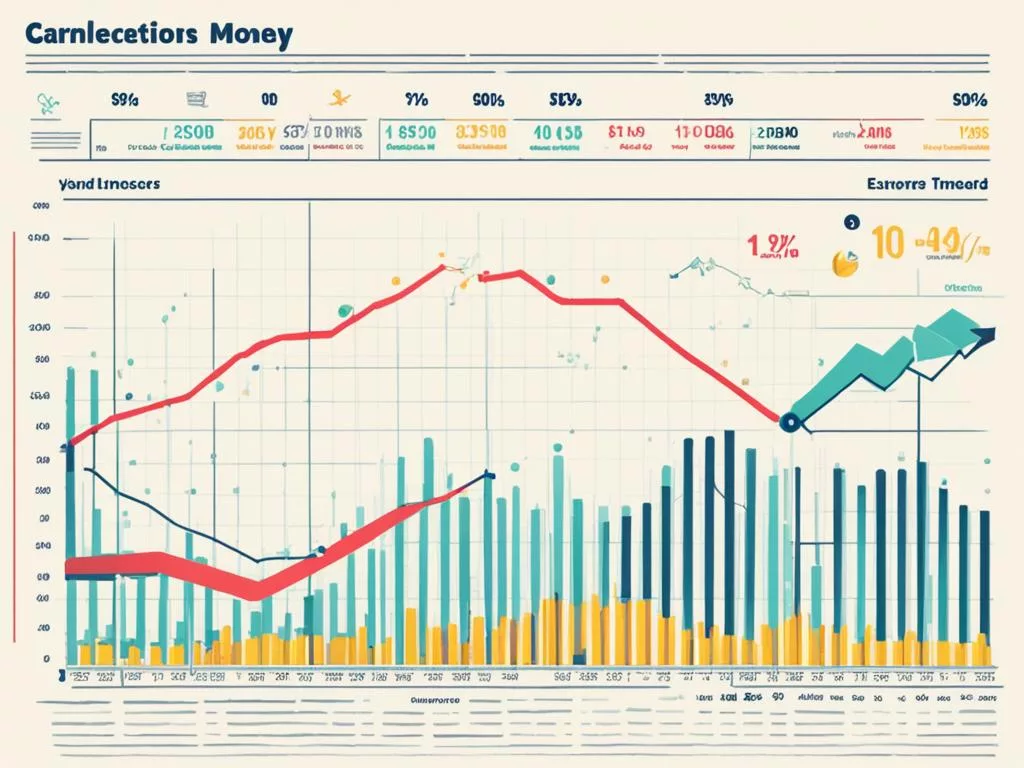As someone who has navigated the complexities of global finance, I understand the weight of each decision when it comes to finding the best way to transfer large sums of money internationally. Whether it’s for purchasing property abroad, investing in international markets, or ensuring family support, secure international funds transfer methods are not just about moving money; they’re about keeping promises and fulfilling dreams. In the tapestry of modern banking, services like Zelle® have woven themselves into the fabric of our daily lives, creating an efficient global money transfer solution that promises speed and security for smaller transactions—transfers are typically within minutes with enrolled users and without transaction fees from institutions like Bank of America1.
Yet, when faced with the necessity of transferring larger amounts, the landscape shifts. It expands beyond the immediacy of Zelle® to a realm where traditional bank transfers and wire transfers play pivotal roles—offering one business day transactions for wire transfers and introducing a nuanced consideration of fees, exchange rates, and transfer speeds12. Each option carries its rhythm, its pulse; from the swift heartbeat of Zelle® for everyday needs to the steady, pressing tempo of wire transfers designed to move mountains. I have learned that in this vast financial ecosystem, there is a dance to money movement, a choreography that balances efficiency with the intricate steps of security and cost-effectiveness. And I invite you to join me in exploring these complex rhythms and discovering the path that resonates with your international money transfer needs.
Understanding the Basics of International Money Transfers
In my experience with overseas money transfer, the mechanics of sending funds abroad require clarity on several fronts, including cost, speed, and reliability. Traditional methods like bank wire transfers usually incur a median outgoing fee of $45, while receiving fees average around $13 from major U.S. financial institutions3. These transactions often involve a markup above the mid-market rate for currency conversion, influencing the overall cost of secure international funds transfers3. Conversely, non-bank services such as Wise and MoneyGram strive to offer more competitive exchange rates, typically charging customers at the mid-market rate or a nominal fee34.
| Service | Average Fee | Speed | Daily Limit |
|---|---|---|---|
| Bank Wire Transfer | $45 | 2 working days3 | N/A |
| Wise (TransferWise) | $6.424 | Up to 2 business days4 | Varies by currency |
| Xoom | 5% + currency fee4 | Minutes4 | Up to $50,0004 |
| MoneyGram | $1.99 with debit card4 | Next business day4 | N/A |
Compliance with financial regulations is essential for any fast money transfer service. For instance, the IRS is notified of any international wire transfer exceeding $10,000, a measure in place to monitor transfers and prevent illegal activities3. Moreover, transactions over $3,000 are subject to information collection by financial institutions3. The ultimate choice for an overseas money transfer would depend on the intended purpose, the desired speed of the transaction, and the necessity for a secure international funds transfer.
- For larger sums and business purposes, bank-to-bank transfers and wire transfers are prevalent for their global acceptance and reliability5.
- ACH transactions, although more common domestically, are starting to be leveraged for multicurrency accounts by some banks and FinTech companies, offering a quick and low-cost avenue5.
- Regions with limited banking infrastructure may find cash-to-cash transfers preferable for immediate access to funds5.
With evolving financial ecosystems, it’s crucial to appraise all available options, ensuring transactions align not just with personal and business needs but also with regulatory frameworks.

Bank-to-Bank Transfers for Secure Transactions
When opting for a reliable cross-border payment method, bank-to-bank overseas money transfer remains a cornerstone in the realm of international finance. Harnessing the data from industry leaders, it’s evident that utilizing account and routing numbers for these transactions can vary by institution, sometimes occurring instantaneously or within a span of days1. This draws attention to the pivotal role that individual bank policies and operational frameworks play in the transfer’s speed and efficiency.

Wire transfers have traditionally stood out for their rapid processing times, whittling down the wait to one business day for large amounts, thus catering to those who prioritize speed1. Banks, upholding stringent security measures, charge a flat fee – around $30 for domestic and roughly $40 for international transfers – cementing wire transfers as a premium, though cost-incurring, service6. A fee is commonly levied on the recipient’s end as well, making it crucial to consider the total cost of a wire transfer from both sender and recipient perspectives6.
| Transfer Type | Processing Time | Sender’s Fee | Recipient’s Fee |
|---|---|---|---|
| Domestic Wire Transfer | 1 business day6 | Around $306 | Approx. $206 |
| International Wire Transfer | 2-3 business days or longer6 | Around $406 | Intermediary fees may apply6 |
| Zelle® (Enrolled Users) | Within minutes1 | Usually free1 | Usually free1 |
Interestingly, services like Zelle® outline a contrasting landscape by offering swift and secure financial transactions to friends and family free of charge, with notable promptness for enrolled users1. Yet, these tend to be more appropriate for smaller, personal sums rather than larger international business transactions. As I explore the various layers of overseas money transfer, assessing the offerings of industry juggernauts like Wise provides additional insight. They are renowned for their transparency in fees and fluctuations in exchange rate markups, advocating for an informed decision-making process7.
- Wise flaunts millions of content customers utilizing their service for global money movement7.
- Their customer satisfaction is underscored by an impressive Trustpilot score of 4.3 based on over 218,000 reviews7.
- Illustrating different fees, such as the $7.65 on a $992.35 conversion, Wise accentuates the importance of clarity in financial dealings7.
When considering the intricate fabric of international financial transfers, bank-to-bank options tailored to larger transactions remain an enduring presence. They may require additional steps and in-person banking activities, thereby influencing the convenience factor in today’s fast-paced world6. However, their entrenched security and the ability to transfer substantial amounts swiftly place them high on the list for those engaged in significant cross-border monetary activities.
Best Way to Transfer Large Sums of Money Internationally
Selecting the best way to transfer large sums of money internationally requires evaluating an interplay of cost, speed, and security. For many, digital payment platforms like Wise offer a compelling combination—they not only promise delivery within two business days but do so at a bargain, usually at a fee of just $6.424. A closer look at the fee structure of international transfers reveals that while traditional wire transfers impose an average outgoing fee of around $44, alternatives like MoneyGram undercut these costs, typically charging $1.99 when using a debit card4. This stark contrast in fees underscores the need to meticulously assess the total costs, incorporating exchange rates and any additional fees for payment methods when choosing an international money transfer service4.
In terms of speed, Xoom stands out with its baseline transfer limit of $2,999 daily, which can swell up to $50,000 with added verification4. Furthermore, transfers through Xoom usually avail funds in the recipient’s PayPal or bank account within minutes, challenging traditional banking wire services that could span two to three business days or longer, depending on factors such as time zones and national holidays6. It’s a similar story with MoneyGram, which also pledges funds delivery to the recipient’s bank account by the next business day4.
Security is non-negotiable when transferring significant amounts, and wire transfers fill this need robustly, as banks shield these transactions with the same protocols employed for safeguarding account information6. Despite the high-level security offered, customers should be mindful of the noncancelable nature of wire transfers, with only rare exceptions subject to approval by the recipient6. Moreover, in adhering to regulatory compliances, banks scrutinize every wire request against sanctions lists mandated by the Office of Foreign Assets Control6.
Taking a broad-view approach, using online money transfer providers can be more cost-effective than bank-to-bank options, with PayPal charging between 0.4 to 2% depending on the destination8. Additionally, these providers must toe the line with regulatory bodies such as the UK’s Financial Conduct Authority, ensuring compliance with state and federal laws in the United States8. Dedicated foreign exchange providers, meanwhile, tend to offer better exchange rates and lower fees thanks to their high transaction volumes, along with more transparency and usually accompanying tools for exchange risk management8. They also tout customer-centric services, like free transfers, 24-hour support, and foreign exchange alerts, making them an increasingly popular choice for an efficient global money transfer solution8.
- For a secure international funds transfer, prioritize options with strong security measures and regulatory adherence.
- An efficient global money transfer solution often balances good exchange rates with lower overall fees.
- The best way to transfer large sums of money internationally typically demands scrutinizing costs, speed, and service options thoroughly.

| Provider | Transfer Limit | Transfer Speed | Fees | Security |
|---|---|---|---|---|
| Wise | Up to $1,000,000 | Up to 2 business days4 | Approx. $6.424 | High-level |
| Xoom by PayPal | $2,999 to $50,000 | Within minutes4 | 5% + fixed currency fee4 | Regulated by FCA and US laws8 |
| MoneyGram | Varies by country | Next business day4 | From $1.99 with debit card4 | High-level |
When pushing forward to make an international money transfer, my advice leans toward exploring and comparing these platforms and providers in depth. By doing so, one can unearth a service that not only accords a secure international funds transfer but does so by being cost-effective and reliably swift—a trinity of qualities paramount for managing overseas money movement effectively.
The Advantages of Wire Transfers for Timely Delivery
In my experience as a financial journalist, I’ve seen first-hand how essential a fast money transfer service can be for individuals and businesses alike. Wire transfers, in particular, have proven to be a reliable cross-border payment method when time is of the essence. Here’s why I find them vastly advantageous:
- Speed: Wire transfers provide nearly instantaneous transactions. If the transfer process is initiated before a bank’s cut-off time, typically 5 p.m. EST in the U.S., the funds can arrive on the same day.
- Security: The involvement of both the sender’s and recipient’s banks safeguards the transaction, and multiple identity checks negate the risk of fraud.
- Accessibility: Despite the need for a bank officer’s in-person initiation, once set up, wire transfers can be managed without visiting a banking facility, facilitated by online and phone services.
Let’s not overlook the fact that wire transfers are held to rigorous standards, reinforcing their status as a secure and dependable choice for major transactions. However, it’s important to consider the fees involved, which can vary depending on the institutions you choose to work with.
Below, I’ve compiled a table that outlines my observations regarding the expediency and security of wire transfers compared to other methods:
| Transfer Method | Speed | Security | Convenience | Cost |
|---|---|---|---|---|
| Wire Transfer | Same-day | High | High | Varies |
| ACH Transfer | 1-2 Business Days | Medium | High | Lower |
| Bank Draft | Several Business Days | High | Medium | Varies |
When detailing the pros and cons of each method, it’s clear that wire transfers strike an optimal balance between speed and security—a critical combination for those who cannot afford delays in fund delivery. Their structured, transparent process offers peace of mind, particularly for time-sensitive transactions.
Finally, as a reference to this section of the article, please note the reference number for further details and statistics on the advantages of wire transfers.
Automated Clearing House Transactions: Efficient and Cost-Effective
In my extensive experience with international money transfers, I’ve found that Automated Clearing House (ACH) transactions stand out as an incredibly efficient global money transfer solution. They encapsulate a wide range of payment types, including online bill payments, direct deposits, and both person-to-person and business-to-business payments9. Often lauded for their low cost, ACH transfers may charge around $3 for sending money between different banks, but many ACH debit transactions, such as payroll direct deposits, come at no extra fee9.
When it comes to sending money abroad, ACH credit transfers and ACH debit transfers provide two options; ACH credit transfers are typically processed within one to two business days, while ACH debit transactions must be settled by the following business day9. Though it’s important to keep in mind that international ACH transfers can be subjected to restrictions, such as transfer limits and international transfer prohibitions, which need to be considered9.
Comparing this to other money transfer services, one sees a striking difference in fee structures. PayPal, for instance, charges a 5% fee for international transfers, which can add up quickly, especially for larger sums10. Meanwhile, institutions like MoneyGram have transfer limits that typically cap at $10,000, but they do extend this limit to $15,000 for specific transactions to Europe10. Despite these limitations, one cannot overlook the expansive reach of companies like Western Union, with its 500,000+ branches worldwide, and OFX’s operation across 190 countries with no maximum transfer cap, underlining the diverse options available for global funds transfer10.
Turning back to ACH’s advantages, its no-fee structure positions it as a sound choice for a no-fee overseas money transfer alternative. Notably, the recent lifting of the six-transfer limit on savings accounts does open up possibilities, although exceeding this number might incur a fee9.

To conclude, while services like Wise boast fast credit and debit card transfers among 70 countries, an ACH transfer could serve as a more cost-effective and methodical approach for moving money across borders, making it an option worthy of consideration for those who prioritize efficiency and cost in their international financial dealings10.
Exploring Cash-to-Cash Transfers for Immediate Access
In my experience, cash-to-cash transfers stand out as a reliable cross-border payment method offering the advantage of immediacy for those requiring swift access to funds internationally. Esteemed services like Western Union, MoneyGram, and Ria exemplify this approach, with extensive networks of physical locations facilitating these transactions. These centers are instrumental for individuals not entrenched in digital financial services or for those in regions where traditional banking infrastructure is scarce. It’s vital, however, to consider the trade-offs such as varying exchange rates and potential service fees, which can influence the total amount received on the other end.
The landscape of immediate access funds transfer is populated with diverse options; navigating through them requires a clear understanding of their limitations and fees. For example, while Zelle’s cash-to-cash transfers allow for sending up to $500 per week, Venmo significantly raises the ceiling to $60,000 per week upon identity verification1112. Crucially, when opting for digital platforms like Apple Cash, one must be cognizant of the 1.5 percent instant transfer fee, which is a critical factor for those transferring larger sums11. Therefore, understanding these digital nuances is as essential as evaluating physical cash-to-cash services.
As someone who prioritizes not just reliability but also cost-effectiveness and promptness, I find that being well-informed about transaction caps and fees across multiple platforms is imperative. Samsung Pay Cash lite accounts’ maximum of $500 transactions, up to 15 times a month, is a good example of how digital services are creating niches within the immediate funds transfer market11. My guidance for anyone engaged in these transfers is to always perform thorough research or consult with a financial expert to ensure that the chosen method not only promises immediate access but also aligns with the financial objectives without undue erosion through fees and exchange rates.
Source Links
- https://www.bankofamerica.com/onlinebanking/education/ways-to-send-money.go
- https://moneytransferexpert.co.uk/transferring-large-sums-of-money-internationally/
- https://www.brex.com/resources/international-wire-transfers-guide
- https://www.bankrate.com/banking/international-money-transfer/
- https://multipass.co/help-centre/knowledge-base/how-to-transfer-large-sums-of-money-for-business-internationally
- https://www.citizensbank.com/learning/what-is-a-wire-transfer.aspx
- https://wise.com/us/send-money/cheapest-way-to-send-money-abroad
- https://www.expatica.com/global/finance/money-management/international-money-transfers-108328/
- https://www.nerdwallet.com/article/banking/ach-transfers
- https://money.com/best-ways-to-send-money-internationally/
- https://www.bankrate.com/banking/best-ways-to-send-money/
- https://www.marketwatch.com/guides/money-transfer/best-ways-to-send-money/

